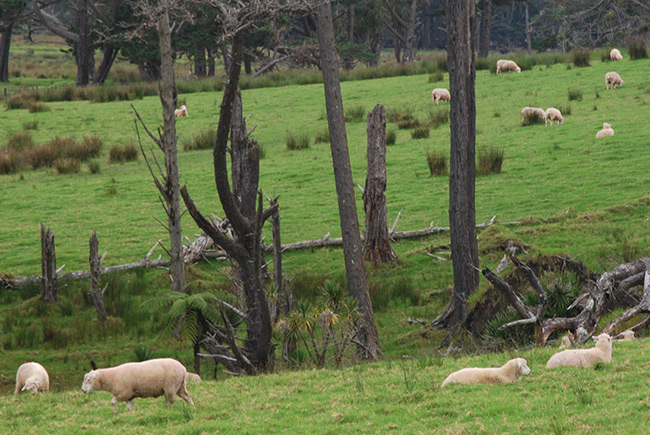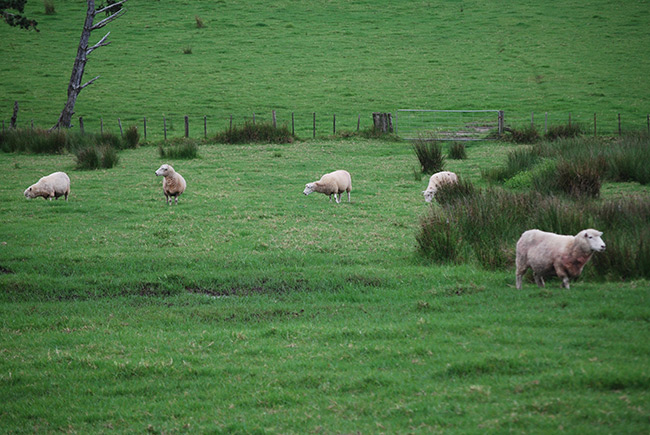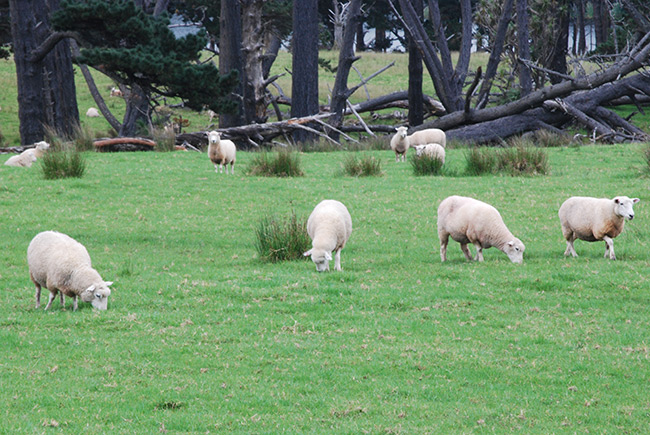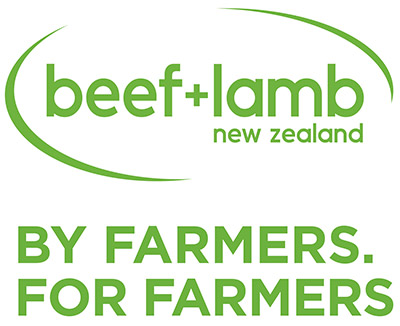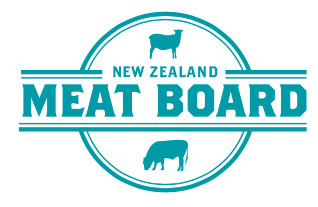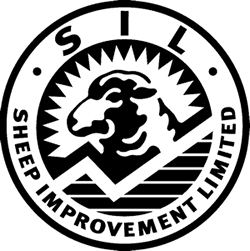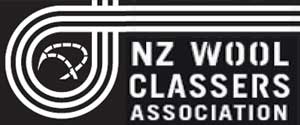Sheep for
wool and meat were integral to the
development of New Zealand, but the industry
has declined in recent decades, ceding to
more profitable land uses, particularly
dairy and vineyards. According to
Stats NZ the sheep population peaked at 70.3
million in 1982 or 22 sheep for every New
Zealander; as of June 2017 there were fewer
than six sheep for every New Zealander or a
total of 27.5 million. One
factor to remember is that whereas there
formerly was significant government
intervention in agriculture, such as
subsidies and tax incentives to increase
stock numbers, in the 1980 the
government ended agricultural
subsidies. There are about 30 major
breeds in New Zealand; the most common breed
being NZ Romney, particularly on the
North Island. Different breeds (
+)
are better suited to different parts of the
country, require more or less maintenance,
and have different wool types.
Northland has a relatively small number of
sheep; according to Stats NZ (
+)
in 2016 there were 366,197 (compare Otago
4.8m, Canterbury 4.6m and Southland
3.7m).
The first export of frozen sheep meat sailed
from Port Chalmers in Otago for Britain in
1882. Today sheep meat now produces
significantly more revenue than wool on the
export market. According to the
Compendium of
New Zealand Farm Facts 2017, the
value of New Zealand exports for the year
ended 30 June 2016 (NZ$ FOB) of raw wool was
$759.7 million compared to $2,568.8 million
for lamb and $419.1 million for
mutton. According to the Ministry for
Primary Industries, New Zealand is the
number one exporter of sheep meat (
+).
For
exports
of
lamb
(by
volume)
China
is
the
biggest market followed by Great
Britain and U.S.A., although regionally the
European Union receives as much as North
Asia.
Most New Zealand wool is the strong type,
used for production of rugs, carpets and
yarn. Synthetic fibers have led
to a significant decline in the New Zealand
wool industry, although it remains a top
wool exporter. Matters reached a
point where in 2001 growers terminated the
New Zealand Wool Board, which, funded by a
levy, had promoted New Zealand wool since
1944. In July 2017
National
Business Review reported, "New
Zealand just fiinished its worst wool season
since the global financial crisis as China,
the largest buyer of the fibre, switched its
preference to fine wool..." Animal
welfare groups have also posed a
challenge. In Nov. 2016 PETA launched
an "I'd rather go naked than wear wool"
campaign. In support of wool, HRH The
Prince of Wales has been an enthusiastic
promoter of its uses and properties and The
Campaign for Wool, of which he is a patron,
has a strong New Zealand component.
- According to Stats NZ, the sheep
population peaked at 70.3 million in
1982 or 22 sheep for every New
Zealander; as of June 2017 there were a
total of 27.5 million or fewer than six
sheep for every New Zealander.
- Northland has a relatively small
number of sheep; according to Stats NZ
in 2016 there were 366,197 (compare
Otago 4.8m, Canterbury 4.6m and
Southland 3.7m).
-
According to
the
Compendium of New
Zealand Farm Facts 2017, "In
2015-16, New Zealand was the
third largest producer of wool
in the world and produced 9.5%
of world production."
However, WorldAtlas reports that
for 2016-17, New Zealand was the
fourth largest producer after
Australia, China and U.S.A.,
accounding for 11% of world
production (
+).
- According to the Compendium
of New Zealand Farm Facts 2017 [NZ$],
"Wool fibre export earnings for the year
ended 30 June 2016 were $760.1 million
FOB. Wool carpet and rug export
receipts were $132.5 million FOB, with
intermediate products (tops, yarns and
sliver) and other final woollen products
contributing a further $47.8 million
FOB. All wool products represented
2.0% ($940.3 million FOB) of the total
value of New Zealand merchandise
exports."
- According to the Ministry for Primary
Industries, New Zealand is the number
one exporter of sheep meat (+).
The
Compendium
reports the value of New Zealand exports
of lamb for the year ended June 30,
2016 (NZ$FOB) was $2,568.8 million
and $419.1 million for mutton.
- According to the Meat Industry
Association, for Jan. 2018 China was the
top export market for New Zealand
sheepmeat by volume and by value.
(NZ$). China accounted for 18,221
tonnes or 42% of the 43,028 tonnes
exported, and $107.1 million or 28% of
the total $381.2 million. The
number two market was the United Kingdom
at 5,312 tonnes or 12% of the total
volume and $50.4 million or 13% of
value.

